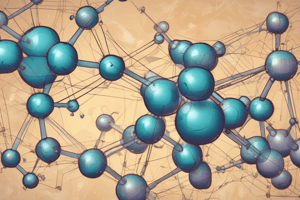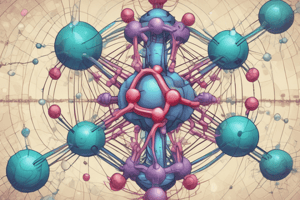Podcast
Questions and Answers
Which compound is more stable towards hydrolysis?
Which compound is more stable towards hydrolysis?
- Both are equally stable
- Neither compound is stable
- CCl4 (correct)
- SiCl4
What primarily determines the relative basicity of a compound?
What primarily determines the relative basicity of a compound?
- pKa values (correct)
- Strength of E-O bond
- Size of the atoms
- Electronegativity of atoms involved
What is the main reason for the difference in reactivity towards hydrolysis between CCl4 and SiCl4?
What is the main reason for the difference in reactivity towards hydrolysis between CCl4 and SiCl4?
- Storage conditions for each compound
- The size of silicon atoms
- Kinetic inertness of CCl4 (correct)
- The bond strength of Si-Cl is weaker than C-Cl
Which of the following is a correct statement about nucleophilicity?
Which of the following is a correct statement about nucleophilicity?
Based on bond enthalpies, which compound is thermodynamically less stable with respect to hydrolysis?
Based on bond enthalpies, which compound is thermodynamically less stable with respect to hydrolysis?
Which bond is considered the most ionic and why?
Which bond is considered the most ionic and why?
Which of the following describes a Lewis base?
Which of the following describes a Lewis base?
Which of the following is identified as a Lewis acid?
Which of the following is identified as a Lewis acid?
Which order correctly ranks the listed elements from least to most electronegative?
Which order correctly ranks the listed elements from least to most electronegative?
What is the correct order of the elements from smallest to largest radius?
What is the correct order of the elements from smallest to largest radius?
Which bond type is primarily characterized by the interaction between main-group elements and carbon?
Which bond type is primarily characterized by the interaction between main-group elements and carbon?
What is the method used to measure the distance (d) between an element and carbon in a bond?
What is the method used to measure the distance (d) between an element and carbon in a bond?
Given an In-C bond length of 223 pm, how is the covalent radius of Indium typically calculated?
Given an In-C bond length of 223 pm, how is the covalent radius of Indium typically calculated?
What is the covalent radius of In?
What is the covalent radius of In?
Which hybridization results in the smallest effective radius for carbon?
Which hybridization results in the smallest effective radius for carbon?
Which of the following elements has a lower electronegativity than carbon?
Which of the following elements has a lower electronegativity than carbon?
What is the bond length of R2C=CR2?
What is the bond length of R2C=CR2?
Which statement about electronegativity is true?
Which statement about electronegativity is true?
Which of the following compounds is classified as unstable?
Which of the following compounds is classified as unstable?
For which bonding type does the effective covalent radius decrease?
For which bonding type does the effective covalent radius decrease?
What is the bond length of R3C-CR3?
What is the bond length of R3C-CR3?
Which electron-attracting tendency is attributed to a high electronegativity in carbon?
Which electron-attracting tendency is attributed to a high electronegativity in carbon?
Among the following elements, which has the highest electronegativity?
Among the following elements, which has the highest electronegativity?
Study Notes
Organometallic Chemistry
- Organometallic compounds contain a bond between a metal (M) or a main-group element (E) and carbon.
- E-C sigma bonds are common, while E=C bonds are less common.
- The chemistry of organometallic compounds is heavily influenced by the specific properties of the main-group element (E).
- Size and electronegativity of E are key factors in determining the stability, reactivity and bond type of organometallic compounds.
Main Group Trends and E-C Bond Lengths
- Electronegativity generally increases across a period and decreases down a group.
- Atomic size generally increases down a group and decreases across a period.
- The covalent radius of an element can be calculated using the bond length and the covalent radius of carbon.
- E refers to a main group element.
- The covalent radius can vary depending on the type of bonding. The covalent radius of Carbon is related to its hybridization (sp3, sp2, sp).
Effects of Electronegativity and Hybridization
- The electronegativity of carbon is 2.5.
- Carbon is more electronegative than most metals but less electronegative than N, O, F, Cl, Br, and I.
- All organometallics are polar, with the metal or main-group element having a partial positive charge and carbon having a partial negative charge.
- The electronegativity of carbon changes with hybridization and increases as s character increases: sp3 < sp2 < sp.
- Increased s character results in increased acidity of C-H bonds.
Reactivity and Thermodynamics of Organometallics
- Main-group organometallic compounds are often thermodynamically unstable due to their susceptibility to oxidation.
- The reactivity and stability of organometallic compounds towards water are influenced by bond strengths and electronegativity differences.
- C-Cl bonds are weaker than C-O bonds, making CCl4 thermodynamically unstable towards hydrolysis, but kinetically inert.
- Si-Cl bonds are weaker than Si-O bonds, resulting in SiCl4 being thermodynamically unstable and kinetically labile towards hydrolysis.
Basicity vs Nucleophilicity
- Basicity is a thermodynamic property that describes a base's ability to donate electrons to a proton. Higher pKa values indicate stronger bases.
- Nucleophilicity is a kinetic property that reflects the ability of a nucleophile to donate electrons to an electrophile. Faster reaction rates indicate stronger nucleophiles.
- Strong bases do not always equate to strong nucleophiles. Steric hindrance and solvation can significantly impact the reactivity of a given nucleophile.
Common Solvents
- Non-polar solvents are generally used for reactions with non-polar organometallic compounds.
- Polar protic solvents are more polar and have a hydrogen atom attached to an electronegative atom.
- Polar aprotic solvents are polar but do not have a hydrogen atom attached to a highly electronegative atom.
- Choice of solvent is important in organometallic chemistry as it can affect the reactivity of the organometallic compound.
Studying That Suits You
Use AI to generate personalized quizzes and flashcards to suit your learning preferences.
Related Documents
Description
Explore the intriguing world of organometallic compounds, focusing on the crucial bond between metals and carbon. This quiz delves into the trends of electronegativity and atomic size, as well as their effects on bond lengths and stability of these compounds. Perfect for chemistry enthusiasts looking to deepen their understanding of main-group elements in organometallic contexts.




